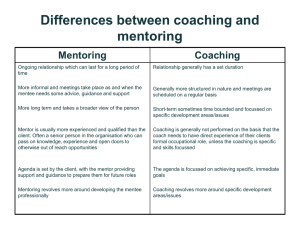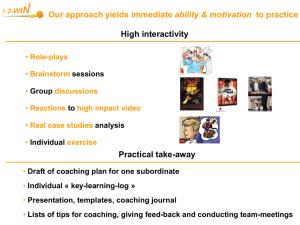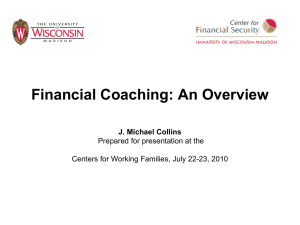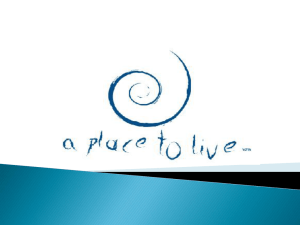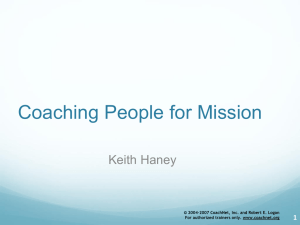Ocean City Professional Learning Institute Conference Presentation
advertisement
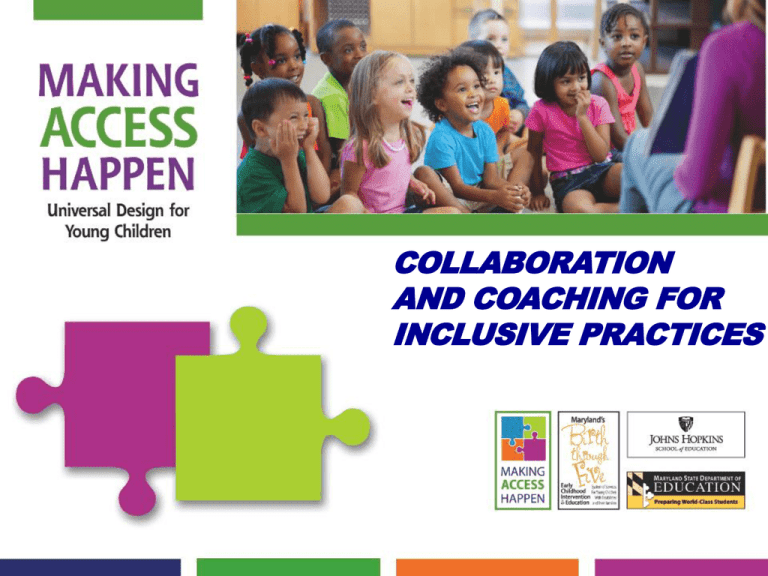
COLLABORATION AND COACHING FOR INCLUSIVE PRACTICES Building Collaborative Partnerships through Coaching and UDL Principles for Effective Implementation of Inclusive Practices PRESENTATION TAKEAWAYS 1. Overview of Implementation Science 2. Coaching and Collaboration Scalability 3. Video Applications for Professional Development 4. Universal Design For Learning Resources 5. Inclusive Practices Scalability IMPLEMENTATION SCIENCE Adapted from Kiser, Blase, & Fixsen, 2013 WHAT IS COACHING? A COACH BUILDS UPON … Knowledge Confidence Action/Practice Reflection Rush & Sheldon, 2005 COLLABORATION AND COACHING Research –evidenced based Definition Tell me, I forget. Show me, I remember. Involve me, I understand. Chinese Proverb IMPORTANCE OF JOINT PLANNING Engaged Learner Active Involvement Participation Throughout Process Trivette, 2009 BUILDING THE COACHING RELATIONSHIP Develop trust and rapport Listen Facilitate selfreflection Effective Feedback – both Coach and Partner MOTIVATION AND EMPOWERMENT How do we motivate others? Why is empowerment so critical? OBSERVATION AND ACTION/PRACTICE The Coach observes the team member in action The Team Member may observe the coach demonstrate additional strategies The Team Member practices use of new strategies or incorporates new knowledge into action. ACTIVE INVOLVEMENT IN THE LEARNING PROCESS Try out new Practice Evaluation/Assessment Multiple Collaborative sessions Reflection VIDEO FOR REFLECTION COACHING WITH VIDEO SELF-MONITORING Enhances reflection process Can be used to build self-reflection skills Allows for repeated observation and review of action/practices UDL IN EARLY CHILDHOOD UDL in early childhood is the intentional design of early intervention programs that enable all children to access, engage in, and learn. Universal design of early education means designing early education environment settings so all children may access and engage in all learning opportunities based on their individual strengths and abilities in multiple ways. MULTIPLE MEANS OF REPRESENTATION MULTIPLE MEANS OF REPRESENTATION MULTIPLE MEANS OF EXPRESSION MULTIPLE MEANS OF EXPRESSION MULTIPLE MEANS OF ENGAGEMENT VIDEO OF DAVID (UDL EXAMPLE) I. Multiple Means of Representation II. Multiple Means of Expression III. Multiple Means of Engagement 1. Provide options for perception 4. Provide options for physical action 7. Provide options for recruiting interest 2. Provide options for language, mathematical expressions, and symbols 5. Provide options for expression and communication 8. Provide options for sustaining effort and persistence 3. Provide options for comprehension 6. Provide options for executive functions 9. Provide options for self-regulation MESSAGE TO COMMUNITY PARTNERS “ I think it’s truly important to know that there are success stories out there.” Patti Adkins, Wicomico County ” SCALABILITY RESEARCH BACKGROUND • Implementation Science Framework • Enhancing Professional Development Practices • Adult Learning Principles • Coaching and Collaboration • Video Enhanced Reflection • Evidenced-based Practices • Universal Design for Learning Principles • Inclusive Practices PROJECT GOALS • To enhance practitioner skills in UDL and collaborative practice using job- embedded professional development activities to support the state’s goal to close the achievement gap for all children. • To establish a cadre of coaching trainers for each jurisdiction to promote and enhance professional development of early care and education providers in evidenced-based practices. • To promote inclusive opportunities in early care and education settings, specific to each jurisdiction’s needs, for children with disabilities, ages 3-5, using evidenced based coaching practices. • To build jurisdictional and state toolkits that are designed to support and sustain the professional development outcomes beyond the scope of the direct program involvement. KEY COMPONENTS 1. Trainer of Trainers Model 2. Personalized to the needs of each jurisdiction 3. Online Toolkit 4. Video Modeling and Reflection PROJECT STEPS • Planning meeting with the Jurisdictional Partners for Grant Development and Goals • Needs Assessment Survey • Implementing Training Support and Resources • Assessing Impact and Sustainability PROJECT ACT PARTNERSHIP INCLUSIVE PRACTICES Video Demonstration (project ACT Example of Little big Girl) – have sharon do this piece and talk about how they support inclusive strategies) ALLEGANY • Building a Core Group of Experts in Coaching and Inclusive Practices • Coaching for Transitions ANNE ARUNDEL Collaboration Academy Collaboration for Successful Transitions WICOMICO • Professional Development in Coaching and Inclusive Practices • Applying the Use of Video into Practice • Transdisciplinary Days – Building in Reflective Opportunities • Hanen Training HARFORD • Development of Year Three Workshops for Child Care Providers • Training of Trainers’ model for the CARA’s Kit • Training of Trainers’ model for coaching in informal care settings TECHNOLOGY TOOLS DROPBOX FOR STORAGE PANOPTO FOR COACHING SUMMARY AND REVIEW Visit us: http://education.jhu.edu/PD/newhorizons/ITPC/UDL CONTACT US John Castellani jcastellani@jhu.edu Beth Boyle beth.boyle@jhu.edu Linda Tsantis tsantis@jhu.edu • Kiser, L., Blase, K.A., & Fixsen, D.L. (2013). The hexagon tool: Exploring context. Chapel Hill, NC: The National Implementation Research Network, FPGChild Development Institute, University of North Carolina at Chapel Hill • Rush & Shelden. (2005). Evidence-based definition of coaching practices. CASEinPoint, 1(6). • Rush, Shelden, & Hanft. (2003). Coaching families and colleagues: A process for collaboration in natural settings. Infants and Young Children, 16, 33-47. • Rush, Shelden, & Raab. (2008). A framework for reflective questioning when using a coaching interaction style. CASEtools, 4(1). • Trivette, C. M., Dunst, C. J., Hamby, D. W., & O'Herin, C. E. (2009). Characteristics and consequences of adult learning methods and strategies [Winterberry Research Syntheses, Vol. 2, Number 2]. Asheville, NC: Winterberry Press. Trivette (2009). Participatory adult learning professional development strategy: Evidence and examples.
